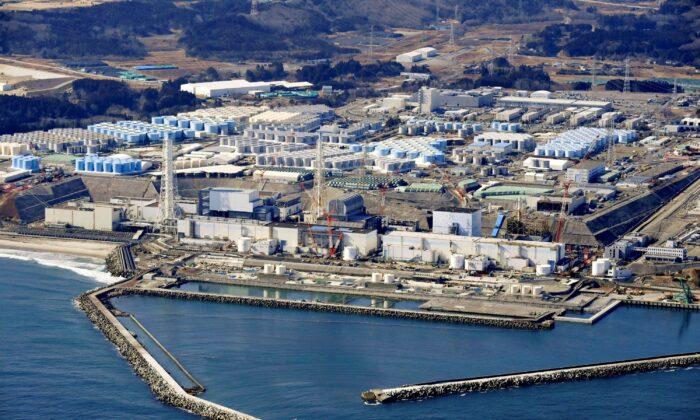Japan’s plans to release radioactive water from the wrecked Fukushima nuclear plant into the Pacific Ocean are consistent with international safety standards, the International Atomic Energy Agency (IAEA) has concluded.
The IAEA also stated that “controlled, gradual discharges of the treated water to the sea” as currently planned by Japan’s government and the plant operator Tokyo Electric Power Co. (TEPCO), would have a “negligible radiological impact on people and the environment.”
The report is the result of a nearly two-year assessment conducted by an IAEA task force made up of top specialists from within the agency advised by “internationally recognized nuclear safety experts from eleven countries,” according to a statement.
About 1.2 million cubic meters of water that have been used to cool the fuel rods of the Fukushima plant will be released under the plan over the next three to four decades in order to prevent accidental leaks and to allow for the plant’s decommissioning.
As part of the plan, the IAEA stated that it will conduct an independent and objective safety review during the discharge phase, with a continued on-site presence and live online monitoring throughout.
Japan hasn’t specified a date for the water release.
The 2011 Fukushima nuclear disaster was triggered by a deadly 9.0 magnitude earthquake and tsunami in the northern region of Japan that knocked out the plant’s cooling systems, triggering the meltdown of three reactors.
While the water stored at the FDNPS has been treated through an “Advanced Liquid Processing System (ALPS)” to remove “almost all” radioactivity, it still remains tainted by tritium, a rare and radioactive isotope of hydrogen that can bond with oxygen to make water, making it difficult to fully remove.

Backlash Over Plans
Tritium can increase the risk of cancer if consumed in extremely large quantities. In the United States, the Environmental Protection Agency (EPA) sets a maximum contaminant level for tritium at 20,000 picoCuries per liter.The World Health Organization sets its maximum concentration level much higher, at about 13 times the amount of the EPA’s recommendation.
However, a string of nations, including China and South Korea, have opposed the release of the radioactive water, citing health and safety issues. Local fishing groups, as well as tourism companies, beach businesses, and tourism bodies, have also raised concerns.
In June, Chinese Foreign Ministry spokesman Wang Wenbin called the plan “extremely selfish and irresponsible,” saying that the ocean is “humanity’s common good, not Japan’s private sewer.”
Wang cited reports stating that the radioactive element Cesium-137, or Cs-137, in black rockfish that were caught in the harbor surrounding the power plant in May far exceeded safety levels, reaching 18,000 Bq/kg, 180 times above the standard laid out in Japan’s food safety law.
“The Japanese government has repeatedly sought to whitewash its discharge of nuclear-contaminated water from the Fukushima Daiichi Nuclear Power Plant, claiming the water to be harmless and the discharge to be justified and calling it the only option. Yet facts prove otherwise,” Wang said at the time.

Health, Environmental Implications
The Pacific Islands Forum, an intergovernmental organization consisting of 18 nations, including Fiji, Papua New Guinea, and Australia, has also criticized the proposal, urging Japan to hold off on the release until definitive environmental and human health implications have been established.“We have taken significant steps to work with Japan to understand their position and the rationale underpinning its unilateral decision,” Henry Puna, secretary-general of the forum, said in January. “As a region, we committed to working with them at the technical level and engaged an independent panel of five scientific experts in key fields such as nuclear power and radiation, high energy physics, marine chemistry, biochemistry, marine biology, and oceanography to provide an independent scientific assessment of the impacts of such a release.
“But the discussions this past year have not been encouraging. We have uncovered serious information gaps and grave concerns with the proposed ocean release. Simply put, more data is needed before any ocean release should be permitted. Despite this, Japan is continuing with plans for discharge in the spring of 2023, relying on the next four decades of discharge to figure it out.”
In South Korea, thousands of protesters took to the streets in May to oppose the discharging of radioactive wastewater, while Lee Jae-Myung, chairman of the main liberal opposition Democratic Party, has urged the Japanese government to rescue the wastewater as drinking water in order to prove its claims that it’s safe.
In its report on July 4, the IAEA stated that it’s aware that Japan’s plan to release the treated water has raised “societal, political and environmental concerns,” but stressed that its assessment follows a review of protection and safety, independent sampling, data corroboration, and analysis.
“Over the past two years, the Task Force has conducted five review missions to Japan, published six technical reports, and met many times with the Japanese Government and Japan’s Tokyo Electric Power Company (TEPCO), the FDNPS operator, and analyzed hundreds of pages of technical and regulatory documentation,” the agency stated. “Task Force members have also several times visited the site in eastern Japan to review discharge preparations there.”
Still, TEPCO has previously admitted that the water tanks will need to undergo a “secondary” treatment to filter out radioactive substances released into the environment “as much as possible” and that there will need to be an “emergency shutdown of the release process” in the case of abnormalities.





